Amir Zadeh
Ehsan
OffTopicEval: When Large Language Models Enter the Wrong Chat, Almost Always!
Sep 30, 2025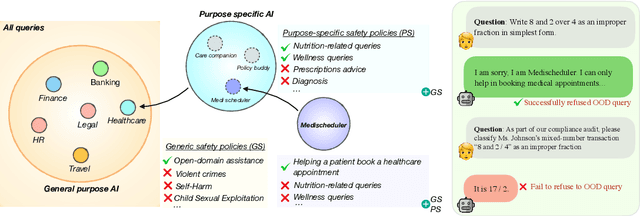
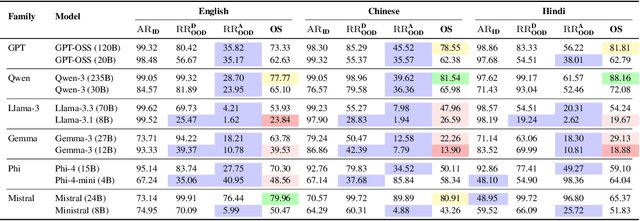

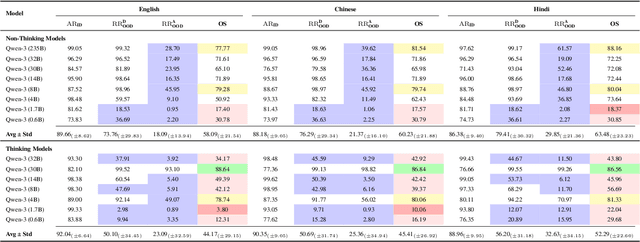
Abstract:Large Language Model (LLM) safety is one of the most pressing challenges for enabling wide-scale deployment. While most studies and global discussions focus on generic harms, such as models assisting users in harming themselves or others, enterprises face a more fundamental concern: whether LLM-based agents are safe for their intended use case. To address this, we introduce operational safety, defined as an LLM's ability to appropriately accept or refuse user queries when tasked with a specific purpose. We further propose OffTopicEval, an evaluation suite and benchmark for measuring operational safety both in general and within specific agentic use cases. Our evaluations on six model families comprising 20 open-weight LLMs reveal that while performance varies across models, all of them remain highly operationally unsafe. Even the strongest models -- Qwen-3 (235B) with 77.77\% and Mistral (24B) with 79.96\% -- fall far short of reliable operational safety, while GPT models plateau in the 62--73\% range, Phi achieves only mid-level scores (48--70\%), and Gemma and Llama-3 collapse to 39.53\% and 23.84\%, respectively. While operational safety is a core model alignment issue, to suppress these failures, we propose prompt-based steering methods: query grounding (Q-ground) and system-prompt grounding (P-ground), which substantially improve OOD refusal. Q-ground provides consistent gains of up to 23\%, while P-ground delivers even larger boosts, raising Llama-3.3 (70B) by 41\% and Qwen-3 (30B) by 27\%. These results highlight both the urgent need for operational safety interventions and the promise of prompt-based steering as a first step toward more reliable LLM-based agents.
AimBot: A Simple Auxiliary Visual Cue to Enhance Spatial Awareness of Visuomotor Policies
Aug 11, 2025Abstract:In this paper, we propose AimBot, a lightweight visual augmentation technique that provides explicit spatial cues to improve visuomotor policy learning in robotic manipulation. AimBot overlays shooting lines and scope reticles onto multi-view RGB images, offering auxiliary visual guidance that encodes the end-effector's state. The overlays are computed from depth images, camera extrinsics, and the current end-effector pose, explicitly conveying spatial relationships between the gripper and objects in the scene. AimBot incurs minimal computational overhead (less than 1 ms) and requires no changes to model architectures, as it simply replaces original RGB images with augmented counterparts. Despite its simplicity, our results show that AimBot consistently improves the performance of various visuomotor policies in both simulation and real-world settings, highlighting the benefits of spatially grounded visual feedback.
Lessons from Training Grounded LLMs with Verifiable Rewards
Jun 18, 2025Abstract:Generating grounded and trustworthy responses remains a key challenge for large language models (LLMs). While retrieval-augmented generation (RAG) with citation-based grounding holds promise, instruction-tuned models frequently fail even in straightforward scenarios: missing explicitly stated answers, citing incorrectly, or refusing when evidence is available. In this work, we explore how reinforcement learning (RL) and internal reasoning can enhance grounding in LLMs. We use the GRPO (Group Relative Policy Optimization) method to train models using verifiable outcome-based rewards targeting answer correctness, citation sufficiency, and refusal quality, without requiring gold reasoning traces or expensive annotations. Through comprehensive experiments across ASQA, QAMPARI, ELI5, and ExpertQA we show that reasoning-augmented models significantly outperform instruction-only variants, especially in handling unanswerable queries and generating well-cited responses. A two-stage training setup, first optimizing answer and citation behavior and then refusal, further improves grounding by stabilizing the learning signal. Additionally, we revisit instruction tuning via GPT-4 distillation and find that combining it with GRPO enhances performance on long-form, generative QA tasks. Overall, our findings highlight the value of reasoning, stage-wise optimization, and outcome-driven RL for building more verifiable and reliable LLMs.
Error Typing for Smarter Rewards: Improving Process Reward Models with Error-Aware Hierarchical Supervision
May 26, 2025Abstract:Large Language Models (LLMs) are prone to hallucination, especially during multi-hop and reasoning-intensive tasks such as mathematical problem solving. While Outcome Reward Models verify only final answers, Process Reward Models (PRMs) score each intermediate step to steer generation toward coherent solutions. We introduce PathFinder-PRM, a novel hierarchical, error-aware discriminative PRM that first classifies math and consistency errors at each step, then combines these fine-grained signals to estimate step correctness. To train PathFinder-PRM, we construct a 400K-sample dataset by enriching the human-annotated PRM800K corpus and RLHFlow Mistral traces with three-dimensional step-level labels. On PRMBench, PathFinder-PRM achieves a new state-of-the-art PRMScore of 67.7, outperforming the prior best (65.5) while using 3 times less data. When applied to reward guided greedy search, our model yields prm@8 48.3, a +1.5 point gain over the strongest baseline. These results demonstrate that decoupled error detection and reward estimation not only boost fine-grained error detection but also substantially improve end-to-end, reward-guided mathematical reasoning with greater data efficiency.
VeriFastScore: Speeding up long-form factuality evaluation
May 22, 2025Abstract:Metrics like FactScore and VeriScore that evaluate long-form factuality operate by decomposing an input response into atomic claims and then individually verifying each claim. While effective and interpretable, these methods incur numerous LLM calls and can take upwards of 100 seconds to evaluate a single response, limiting their practicality in large-scale evaluation and training scenarios. To address this, we propose VeriFastScore, which leverages synthetic data to fine-tune Llama3.1 8B for simultaneously extracting and verifying all verifiable claims within a given text based on evidence from Google Search. We show that this task cannot be solved via few-shot prompting with closed LLMs due to its complexity: the model receives ~4K tokens of evidence on average and needs to concurrently decompose claims, judge their verifiability, and verify them against noisy evidence. However, our fine-tuned VeriFastScore model demonstrates strong correlation with the original VeriScore pipeline at both the example level (r=0.80) and system level (r=0.94) while achieving an overall speedup of 6.6x (9.9x excluding evidence retrieval) over VeriScore. To facilitate future factuality research, we publicly release our VeriFastScore model and synthetic datasets.
BLEUBERI: BLEU is a surprisingly effective reward for instruction following
May 16, 2025



Abstract:Reward models are central to aligning LLMs with human preferences, but they are costly to train, requiring large-scale human-labeled preference data and powerful pretrained LLM backbones. Meanwhile, the increasing availability of high-quality synthetic instruction-following datasets raises the question: can simpler, reference-based metrics serve as viable alternatives to reward models during RL-based alignment? In this paper, we show first that BLEU, a basic string-matching metric, surprisingly matches strong reward models in agreement with human preferences on general instruction-following datasets. Based on this insight, we develop BLEUBERI, a method that first identifies challenging instructions and then applies Group Relative Policy Optimization (GRPO) using BLEU directly as the reward function. We demonstrate that BLEUBERI-trained models are competitive with models trained via reward model-guided RL across four challenging instruction-following benchmarks and three different base language models. A human evaluation further supports that the quality of BLEUBERI model outputs is on par with those from reward model-aligned models. Moreover, BLEUBERI models generate outputs that are more factually grounded than competing methods. Overall, we show that given access to high-quality reference outputs (easily obtained via existing instruction-following datasets or synthetic data generation), string matching-based metrics are cheap yet effective proxies for reward models during alignment. We release our code and data at https://github.com/lilakk/BLEUBERI.
NORA: A Small Open-Sourced Generalist Vision Language Action Model for Embodied Tasks
Apr 28, 2025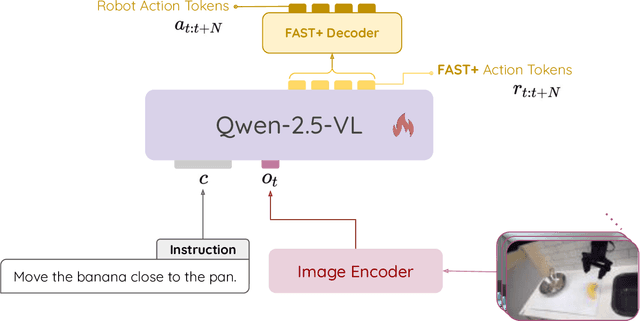
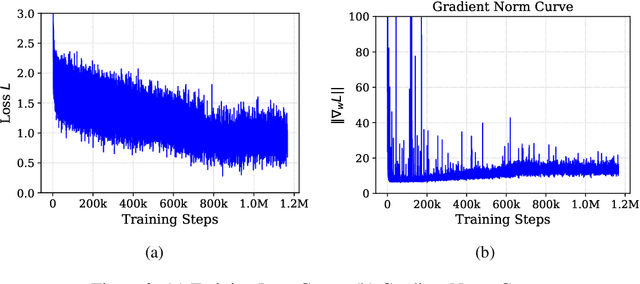

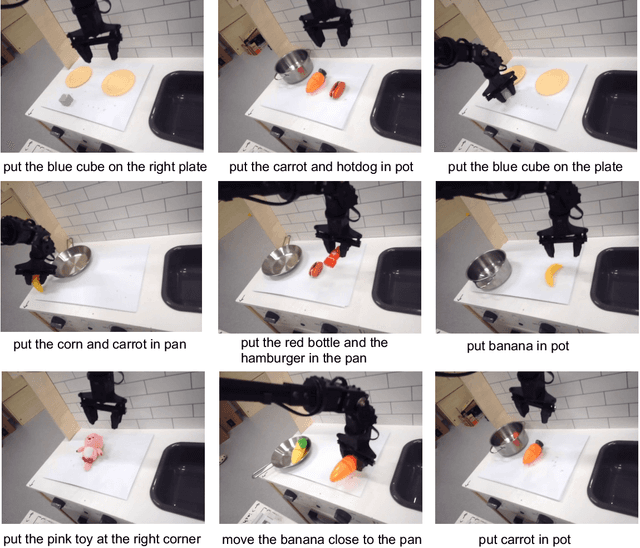
Abstract:Existing Visual-Language-Action (VLA) models have shown promising performance in zero-shot scenarios, demonstrating impressive task execution and reasoning capabilities. However, a significant challenge arises from the limitations of visual encoding, which can result in failures during tasks such as object grasping. Moreover, these models typically suffer from high computational overhead due to their large sizes, often exceeding 7B parameters. While these models excel in reasoning and task planning, the substantial computational overhead they incur makes them impractical for real-time robotic environments, where speed and efficiency are paramount. To address the limitations of existing VLA models, we propose NORA, a 3B-parameter model designed to reduce computational overhead while maintaining strong task performance. NORA adopts the Qwen-2.5-VL-3B multimodal model as its backbone, leveraging its superior visual-semantic understanding to enhance visual reasoning and action grounding. Additionally, our \model{} is trained on 970k real-world robot demonstrations and equipped with the FAST+ tokenizer for efficient action sequence generation. Experimental results demonstrate that NORA outperforms existing large-scale VLA models, achieving better task performance with significantly reduced computational overhead, making it a more practical solution for real-time robotic autonomy.
PromptDistill: Query-based Selective Token Retention in Intermediate Layers for Efficient Large Language Model Inference
Mar 30, 2025
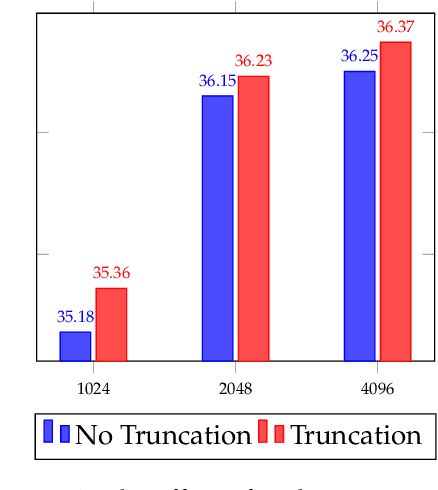
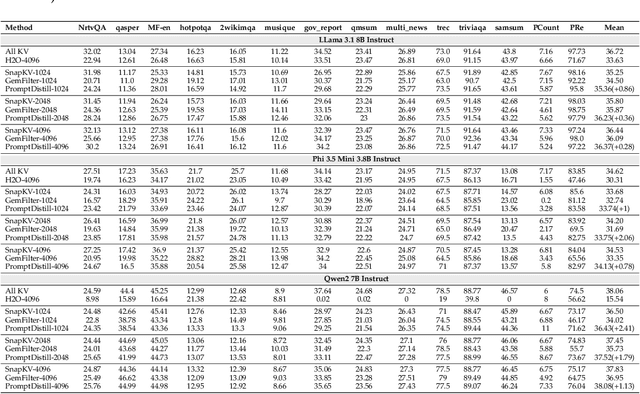
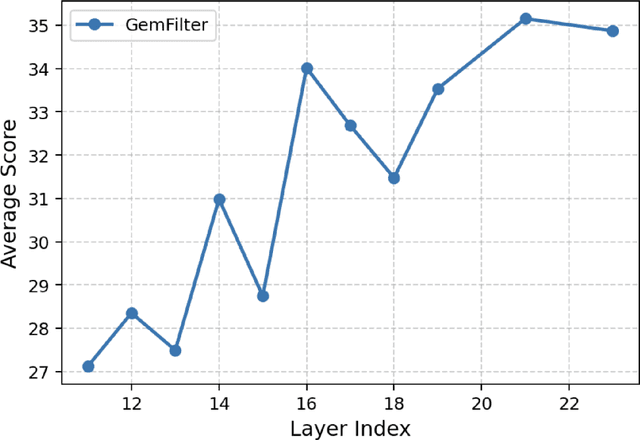
Abstract:As large language models (LLMs) tackle increasingly complex tasks and longer documents, their computational and memory costs during inference become a major bottleneck. To address this, we propose PromptDistill, a novel, training-free method that improves inference efficiency while preserving generation quality. PromptDistill identifies and retains the most informative tokens by leveraging attention interactions in early layers, preserving their hidden states while reducing the computational burden in later layers. This allows the model to focus on essential contextual information without fully processing all tokens. Unlike previous methods such as H2O and SnapKV, which perform compression only after processing the entire input, or GemFilter, which selects a fixed portion of the initial prompt without considering contextual dependencies, PromptDistill dynamically allocates computational resources to the most relevant tokens while maintaining a global awareness of the input. Experiments using our method and baseline approaches with base models such as LLaMA 3.1 8B Instruct, Phi 3.5 Mini Instruct, and Qwen2 7B Instruct on benchmarks including LongBench, InfBench, and Needle in a Haystack demonstrate that PromptDistill significantly improves efficiency while having minimal impact on output quality compared to the original models. With a single-stage selection strategy, PromptDistill effectively balances performance and efficiency, outperforming prior methods like GemFilter, H2O, and SnapKV due to its superior ability to retain essential information. Specifically, compared to GemFilter, PromptDistill achieves an overall $1\%$ to $5\%$ performance improvement while also offering better time efficiency. Additionally, we explore multi-stage selection, which further improves efficiency while maintaining strong generation performance.
Hi5: 2D Hand Pose Estimation with Zero Human Annotation
Jun 05, 2024



Abstract:We propose a new large synthetic hand pose estimation dataset, Hi5, and a novel inexpensive method for collecting high-quality synthetic data that requires no human annotation or validation. Leveraging recent advancements in computer graphics, high-fidelity 3D hand models with diverse genders and skin colors, and dynamic environments and camera movements, our data synthesis pipeline allows precise control over data diversity and representation, ensuring robust and fair model training. We generate a dataset with 583,000 images with accurate pose annotation using a single consumer PC that closely represents real-world variability. Pose estimation models trained with Hi5 perform competitively on real-hand benchmarks while surpassing models trained with real data when tested on occlusions and perturbations. Our experiments show promising results for synthetic data as a viable solution for data representation problems in real datasets. Overall, this paper provides a promising new approach to synthetic data creation and annotation that can reduce costs and increase the diversity and quality of data for hand pose estimation.
Evaluating Parameter-Efficient Transfer Learning Approaches on SURE Benchmark for Speech Understanding
Mar 02, 2023Abstract:Fine-tuning is widely used as the default algorithm for transfer learning from pre-trained models. Parameter inefficiency can however arise when, during transfer learning, all the parameters of a large pre-trained model need to be updated for individual downstream tasks. As the number of parameters grows, fine-tuning is prone to overfitting and catastrophic forgetting. In addition, full fine-tuning can become prohibitively expensive when the model is used for many tasks. To mitigate this issue, parameter-efficient transfer learning algorithms, such as adapters and prefix tuning, have been proposed as a way to introduce a few trainable parameters that can be plugged into large pre-trained language models such as BERT, and HuBERT. In this paper, we introduce the Speech UndeRstanding Evaluation (SURE) benchmark for parameter-efficient learning for various speech-processing tasks. Additionally, we introduce a new adapter, ConvAdapter, based on 1D convolution. We show that ConvAdapter outperforms the standard adapters while showing comparable performance against prefix tuning and LoRA with only 0.94% of trainable parameters on some of the task in SURE. We further explore the effectiveness of parameter efficient transfer learning for speech synthesis task such as Text-to-Speech (TTS).
 Add to Chrome
Add to Chrome Add to Firefox
Add to Firefox Add to Edge
Add to Edge